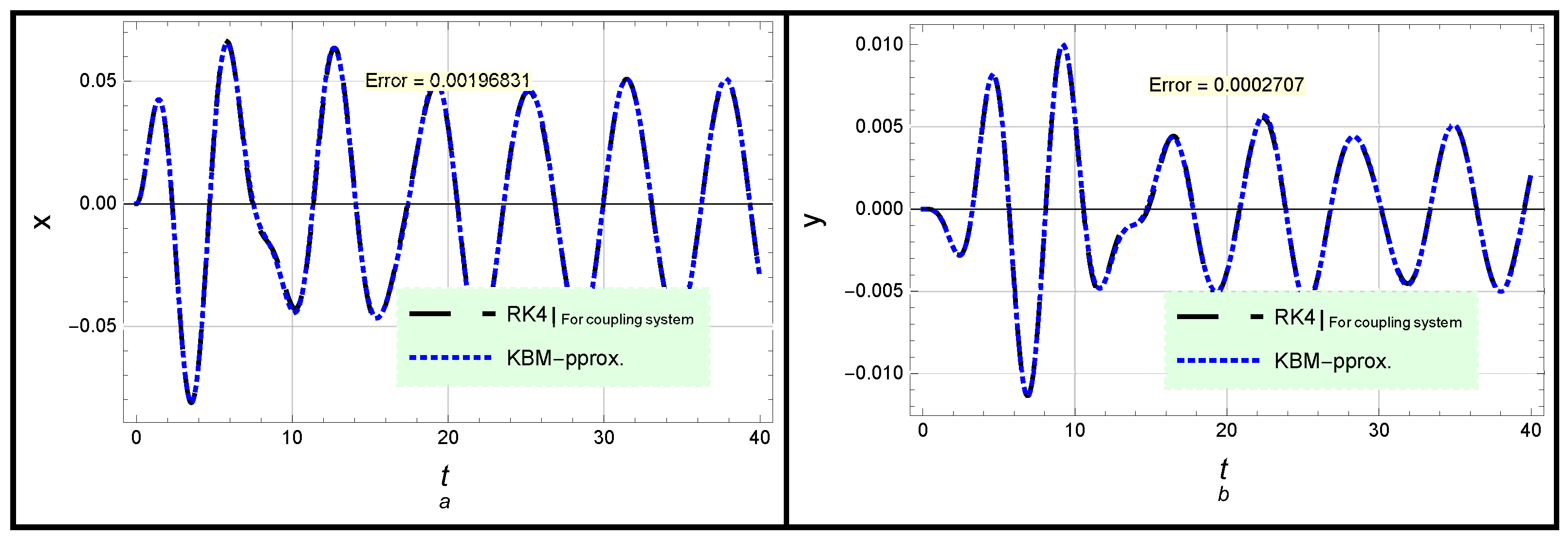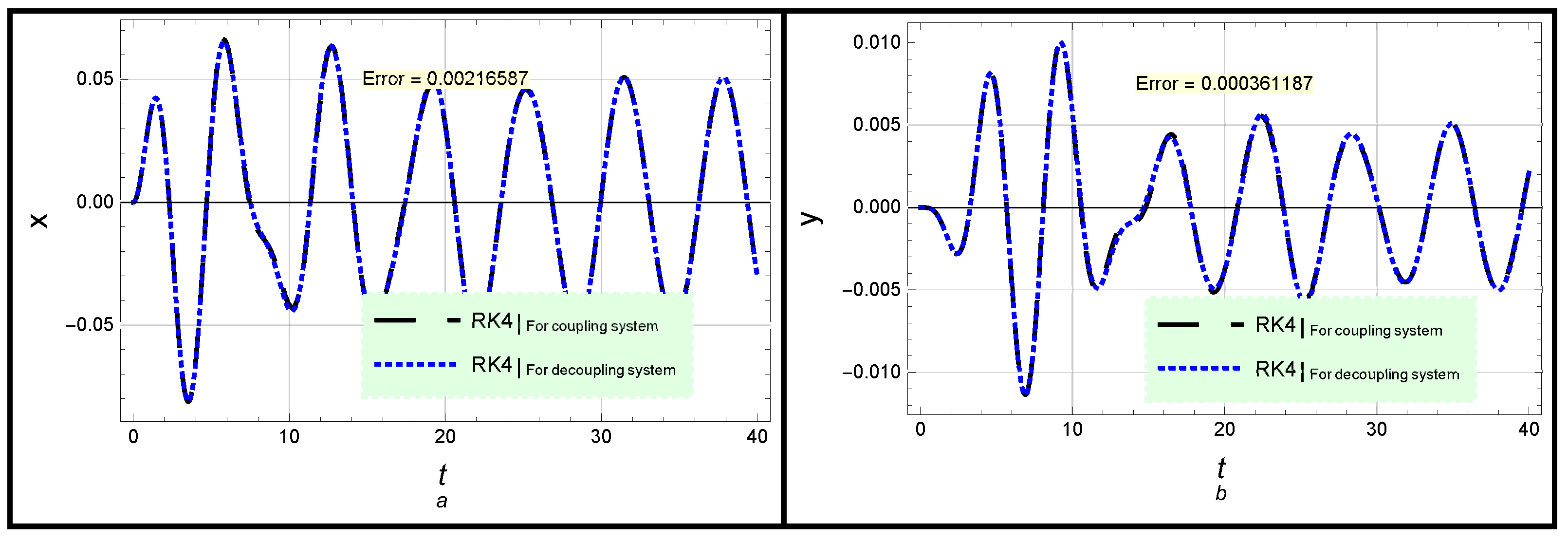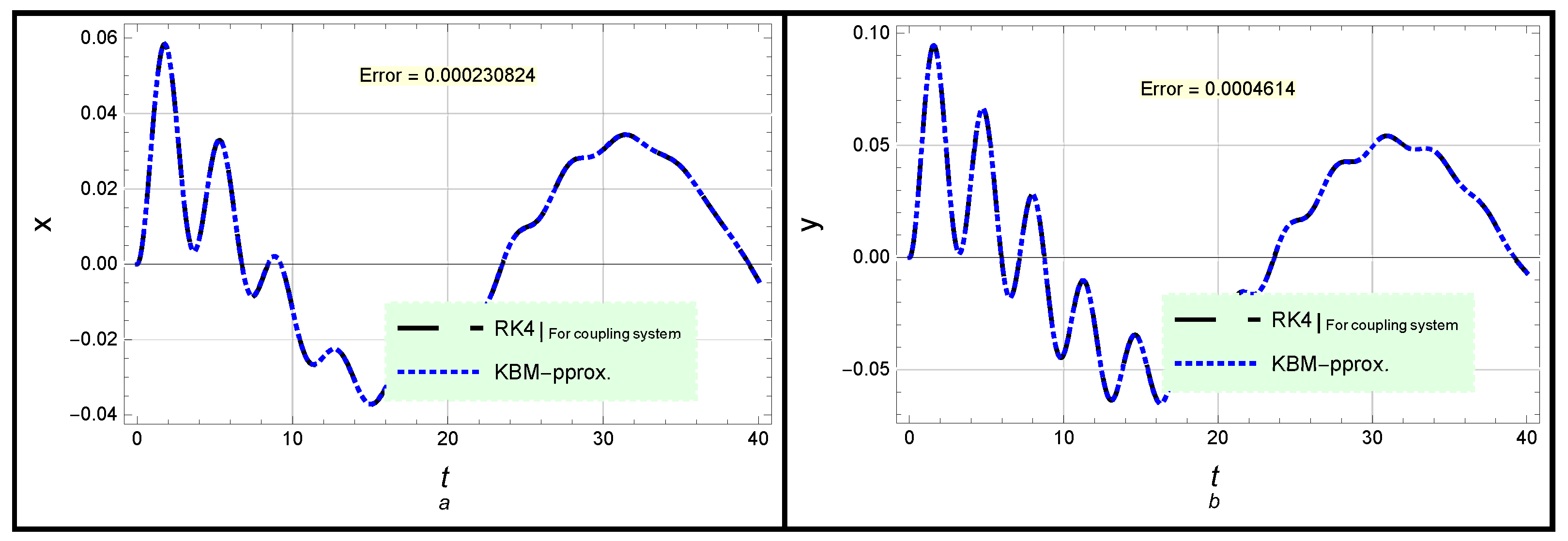Analytical and Numerical Approximations to Some Coupled Forced Damped Duffing Oscillators
Abstract
1. Introduction
2. Decoupling the Two Models of Coupled FDDOs
2.1. Decoupling the First Model (4) to Two Individual FDDOs
2.2. Decoupling the Second Model (6) to Two Individual FDDOs
3. KBM Technique for Analyzing the FDDO (17)
4. Conclusions
Author Contributions
Funding
Institutional Review Board Statement
Informed Consent Statement
Data Availability Statement
Acknowledgments
Conflicts of Interest
Appendix A. The Coefficients of Equation (36)
Appendix B. The Values of the Coefficients Si of Equation (39)
References
- Tunç, C.; Tunç, O. A note on the stability and boundedness of solutions to non-linear differential systems of second order. J. Assoc. Arab Univ. Basic Appl. Sci. 2017, 24, 169. [Google Scholar] [CrossRef]
- Moulai-Khatir, A.; Remili, M.; Beldjerd, D. On asymptotic behaviors for a kind of third order neutral delay differential equations. An. Univ. Din Oradea Fasc. Mat. 2020, 27, 5–16. [Google Scholar]
- Duffing, G. Erzwungene schwingungen bei veränderlicher eigenfrequenz und ihre technische bedeutung. In Vieweg und Sohn, Braunschweig Sammlung Vieweg; Vieweg: Braunschweig, Germany, 1918; pp. 41–42. [Google Scholar]
- Hernández, J.M. The Duffing Oscillator Equation and Its Applications in Physics. Math. Probl. Eng. 2021, 2021, 9994967. [Google Scholar]
- Narasimha, R. Non-linear vibration of an elastic string. J. Sound Vib. 1968, 8, 134. [Google Scholar] [CrossRef]
- Sabarathinam, S.; Thamilmaran, K.; Borkowski, L.; Perlikowski, P.; Brzeski, P.; Stefanski, A.; Kapitaniak, T. Transient chaos in two coupled, dissipatively perturbed Hamiltonian Duffing oscillators. Commun. Nonlinear Sci. Numer. Simulat. 2013, 18, 3098. [Google Scholar] [CrossRef]
- Jothimurugan, R.; Thamilmaran, K.; Rajasekar, S.; Sanjuán, M.A.F. Multiple resonance and anti-resonance in coupled Duffing oscillators. Nonlinear Dyn. 2016, 83, 1803. [Google Scholar] [CrossRef]
- Musielak, D.E.; Musielak, Z.E.; Benner, J.W. Chaos and routes to chaos in coupled Duffing oscillators with multiple degrees of freedom. Chaos Solitons Fractals 2005, 24, 907. [Google Scholar] [CrossRef]
- Lenci, S. Exact solutions for coupled Duffing oscillators. Mech. Syst. Signal Process. 2022, 165, 108299. [Google Scholar] [CrossRef]
- Vincent, U.E.; Njah, A.N.; Akinlade, O.; Solarin, A.R.T. Synchronization of Cross-Well Chaos in Coupled Duffing Oscillators. Int. J. Mod. Phys. B 2005, 19, 3205. [Google Scholar] [CrossRef]
- Alhejaili, W.; Salas, A.H.; El-Tantawy, S.A. Approximate solution to a generalized Van der Pol equation arising in plasma oscillations. AIP Adv. 2022, 12, 105104. [Google Scholar] [CrossRef]
- Salas, A.H.; Albalawi, W.; El-Tantawy, S.A.; El-Sherif, L.S. Some Novel Approaches for Analyzing the Unforced and Forced Duffing–Van der Pol Oscillators. J. Math. 2022, 2022, 2174192. [Google Scholar] [CrossRef]
- Cai, J. A Generalized KBM Method for Strongly Nonlinear Oscillators with Slowly Varying Parameters. Math. Comput. Appl. 2007, 12, 21–30. [Google Scholar] [CrossRef]
- Alhejaili, W.; Salas, A.H.; El-Tantawy, S.A. Novel Approximations to the (Un)forced Pendulum–Cart System: Ansatz and KBM Methods. Mathematics 2022, 10, 2908. [Google Scholar] [CrossRef]
- Yamgoué, S.B.; Kofanxex, T.C. Application of the Krylov–Bogoliubov–Mitropolsky method to weakly damped strongly non-linear planar Hamiltonian systems. Int. J. Non-Linear Mech. 2007, 42, 1240. [Google Scholar] [CrossRef]
- Alyousef, H.A.; Salas, A.H.; Alharthi, M.R.; El-Tantawy, S.A. Galerkin method, ansatz method, and He’s frequency formulation for modeling the forced damped parametric driven pendulum oscillators. J. Low Freq. Noise Vib. Act. Control 2022, 41, 1426. [Google Scholar] [CrossRef]
- El-Dib, Y.O. The periodic property of Gaylord’s oscillator with a non-perturbative method. Arch. Appl. Mech. 2022, 92, 3067. [Google Scholar] [CrossRef]
- El-Dib, Y.O. An efficient approach to solving fractional Van der Pol–Duffing jerk oscillator. Commun. Theor. Phys. 2022, 74, 105006. [Google Scholar] [CrossRef]
- El-Dib, Y.O.; Elgazery, N.S. A novel pattern in a class of fractal models with the non-perturbative approach. Chaos Solitons Fractals 2022, 164, 112694. [Google Scholar] [CrossRef]
- Bezziou, M.; Jebril, I.; Dahmani, Z. A new nonlinear duffing system with sequential fractional derivatives. Chaos Solitons Fractals 2021, 151, 111247. [Google Scholar] [CrossRef]
- Hammad, M.A.; Salas, A.H.; El-Tantawy, S.A. New method for solving strong conservative odd parity nonlinear oscillators: Applications to plasma physics and rigid rotator. Aip Adv. 2020, 10, 085001. [Google Scholar] [CrossRef]



Publisher’s Note: MDPI stays neutral with regard to jurisdictional claims in published maps and institutional affiliations. |
© 2022 by the authors. Licensee MDPI, Basel, Switzerland. This article is an open access article distributed under the terms and conditions of the Creative Commons Attribution (CC BY) license (https://creativecommons.org/licenses/by/4.0/).
Share and Cite
Salas, A.H.; Abu Hammad, M.; Alotaibi, B.M.; El-Sherif, L.S.; El-Tantawy, S.A. Analytical and Numerical Approximations to Some Coupled Forced Damped Duffing Oscillators. Symmetry 2022, 14, 2286. https://doi.org/10.3390/sym14112286
Salas AH, Abu Hammad M, Alotaibi BM, El-Sherif LS, El-Tantawy SA. Analytical and Numerical Approximations to Some Coupled Forced Damped Duffing Oscillators. Symmetry. 2022; 14(11):2286. https://doi.org/10.3390/sym14112286
Chicago/Turabian StyleSalas, Alvaro H., Mamon Abu Hammad, Badriah M. Alotaibi, Lamiaa S. El-Sherif, and Samir A. El-Tantawy. 2022. "Analytical and Numerical Approximations to Some Coupled Forced Damped Duffing Oscillators" Symmetry 14, no. 11: 2286. https://doi.org/10.3390/sym14112286
APA StyleSalas, A. H., Abu Hammad, M., Alotaibi, B. M., El-Sherif, L. S., & El-Tantawy, S. A. (2022). Analytical and Numerical Approximations to Some Coupled Forced Damped Duffing Oscillators. Symmetry, 14(11), 2286. https://doi.org/10.3390/sym14112286







